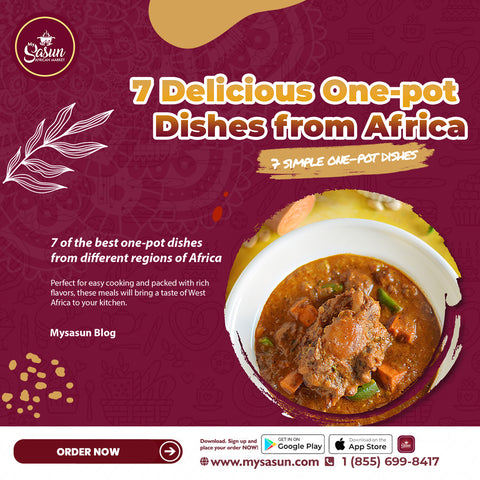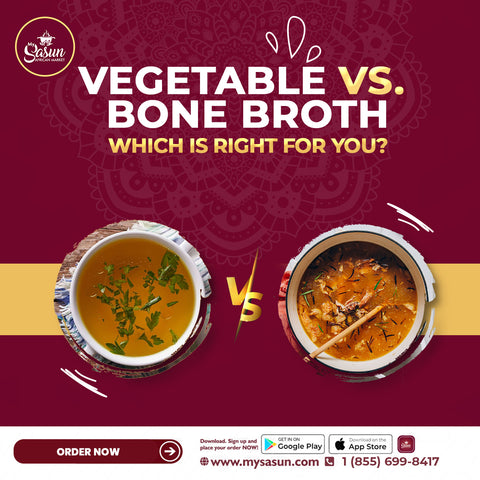One-pot dishes are a lifesaver in the kitchen. They’re easy to make, require minimal cleanup, and still deliver tons of flavor. Africa is home to some of the most comforting and flavorful one-pot meals you’ll ever try and these dishes are both flavorful and convenient. These meals are not only easy to prepare but also pack a punch in terms of nutrition and taste. Here’s a look at 7 of the best one-pot dishes from different regions of Africa:
Also Read: Top African Rice Dishes You Must Try
1. Peanut Stew (Mafé)
How It’s Made:
Mafé is a creamy, nutty stew popular in West Africa, particularly in Senegal, Mali, and The Gambia. It’s made by simmering peanut butter with tomatoes, onions, garlic, and a blend of spices. You can add beef, chicken, or lamb, along with vegetables like carrots, sweet potatoes, or okra. The result is a rich and hearty stew that's typically served over rice.
Nutritional Value:
Mafé is high in protein and healthy fats, thanks to the peanut butter and meat. It’s also rich in vitamins and minerals from the vegetables, thereby making it a balanced and nutritious meal.
Cooking Time:
Mafé takes about 1 to 1.5 hours to prepare, including time to cook the meat and let the flavors meld together.
2. Pilau
How It’s Made:
Pilau is a fragrant rice dish that’s a staple in East African countries like Kenya and Tanzania. It’s made by cooking rice with a blend of spices, including cumin, cardamom, cinnamon, and cloves. Often, it’s cooked with meat such as beef, chicken, or lamb, and it’s served with Kachumbari, a fresh tomato and onion salad.
Nutritional Value:
Pilau is a good source of carbohydrates from the rice, along with protein from the meat. The spices used in pilau also offer various health benefits, such as anti-inflammatory properties.
Cooking Time:
Pilau typically takes about 45 minutes to an hour to prepare, depending on whether you include meat.
Also Read: 11 Must-Try African Vegan Dishes
3. Jollof Rice
How It’s Made:
Jollof Rice is a popular dish across West Africa, particularly in Nigeria and Ghana. It’s made by cooking rice in a tomato-based sauce that’s seasoned with onions, garlic, thyme, and chili peppers. Often, it includes vegetables like bell peppers, carrots, and peas, and can be cooked with chicken, beef, or fish.
Nutritional Value:
Jollof Rice provides a good balance of carbohydrates, vitamins, and minerals from the rice and vegetables. Adding meat or fish increases the protein content, making it a well-rounded meal.
Cooking Time:
Jollof Rice takes about 45 minutes to 1 hour to cook, depending on the type of rice and whether you add meat.
And to make your Jollof Rice adventure even much ibteresting, we have curated all the must-have ingredients for you. Click here to access the collection
4. Thieboudienne
How It’s Made:
Thieboudienne, also known as "Ceebu Jen," is the national dish of Senegal. It’s a flavorful one-pot dish made with fish, rice, and vegetables like carrots, cabbage, and cassava. The fish is typically marinated in a blend of herbs and spices before being cooked with the rice and vegetables in a tomato-based sauce.
Nutritional Value:
Thieboudienne is rich in protein from the fish, as well as vitamins and minerals from the variety of vegetables. The dish is also a good source of carbohydrates from the rice.
Cooking Time:
Thieboudienne takes about 1.5 to 2 hours to prepare, allowing time for the fish to marinate and the rice to absorb all the flavors.
Also Read: Three Flavorful Coconut Dishes You Should Try
5. Kedjenou
How It’s Made:
Kedjenou is a spicy stew from Ivory Coast, traditionally made with chicken or guinea fowl. The meat is slow-cooked with tomatoes, onions, and a variety of spices in a sealed pot, which helps to retain moisture and intensify the flavors. It’s usually served with attiéké, a side dish made from ground cassava.
Nutritional Value:
Kedjenou is high in protein and low in fat, especially if you use lean meat like chicken. The dish is also rich in vitamins from the tomatoes and onions, and attiéké provides carbohydrates.
Cooking Time:
Kedjenou takes about 1 hour to cook, with additional time for preparation.
6. Chakalaka
How It’s Made:
Chakalaka is a spicy South African vegetable relish made with tomatoes, beans, onions, carrots, and bell peppers. It’s often spiced with curry powder and chili peppers. Chakalaka can be served as a side dish or enjoyed as a meal on its own, especially when paired with pap (a type of maize porridge).
Nutritional Value:
Chakalaka is rich in fiber, vitamins, and antioxidants from the variety of vegetables. When paired with pap, it provides a good balance of carbohydrates and nutrients.
Cooking Time:
Chakalaka takes about 30 to 40 minutes to prepare, making it a quick and nutritious option.
Also Read: 10 Authentic West African Beef Dishes You Must Try
7. Matoke
How It’s Made:
Matoke is a staple dish in Uganda, made from steamed and mashed green bananas. The bananas are cooked in a flavorful sauce made from onions, tomatoes, and sometimes meat or vegetables. Matoke is often served with a meat stew or beans.
Nutritional Value:
Matoke is high in carbohydrates and fiber from the bananas. When cooked with meat or beans, it also provides a good amount of protein and essential nutrients.
Cooking Time:
Matoke takes about 45 minutes to an hour to prepare, depending on whether you include meat or additional vegetables.
Also Read: How to Make the Best Nigerian Peppered Grilled Turkey Wings
ADVANTAGES OF ONE-POT DISHES
Here are some of the key advantages of cooking one-pot meals:
1. Easy Preparation
One-pot dishes simplify the cooking process. With everything cooked in a single pot, there's less chopping, measuring, and juggling of multiple pans. This makes the preparation faster and less stressful, even for complex recipes.
2. Less Cleanup
One of the biggest benefits of one-pot meals is the reduced cleanup. With only one pot (and possibly a cutting board and a few utensils) to wash, you save time and effort on post-meal cleanup. This is especially valuable on busy weeknights.
3. Enhanced Flavors
Cooking everything together in one pot allows the flavors to meld and intensify. The ingredients have time to infuse the dish with their flavors- this creates a rich and cohesive taste that’s often hard to achieve with multi-pot meals.
Also Read: Top 13 Traditional Nigerian Breakfast Dishes You Need to Try
4. Nutrient Retention
One-pot cooking often involves simmering or slow-cooking, which helps retain the nutrients in vegetables and meats. Unlike boiling, where nutrients can be lost in the water, one-pot dishes often keep all the juices and nutrients within the pot.
5. Versatility
One-pot meals are incredibly versatile. You can mix and match ingredients based on what you have on hand and this makes it easy to adapt recipes to your preferences or dietary needs. The options are endless no matter what you are cooking- a stew, casserole, or stir-fry..
6. Budget-Friendly
Cooking one-pot meals often requires fewer ingredients and less meat, making them more cost-effective. You can easily bulk up the dish with inexpensive items like beans, grains, and vegetables, stretching your grocery budget further.
7. Great for Batch Cooking
One-pot dishes are ideal for batch cooking. You can make a large quantity at once and enjoy leftovers throughout the week. This is perfect for meal prepping and ensures you have home-cooked meals ready to go in your fridge/freezer.
8. Time-Saving
With everything cooking together in one pot, you save time both in preparation and in monitoring the cooking process. Many one-pot dishes are also designed to cook slowly, allowing you to do other things while the meal simmers.
9. Comforting and Satisfying
There’s something inherently comforting about one-pot meals. Whether it’s a hearty stew, a creamy risotto, or a flavorful curry, these dishes are often warm, filling, and deeply satisfying, making them perfect for any time of year.
Also Read: 15 Must-Try Nigerian Dishes That Will Blow Your Mind
10. Perfect for All Skill Levels
One-pot dishes are great for both beginners and experienced cooks. For beginners, they offer a straightforward way to prepare a complete meal without getting overwhelmed. For experienced cooks, one-pot meals provide a canvas to experiment with flavors and techniques.
ROUNDING OFF: In summary, one-pot dishes offer convenience, flavor, and nutrition all in one go. These meals make it easy to create something delicious with minimal effort.
FAQs
Which one-pot dish is the easiest to start with?
Jollof Rice is a great option for beginners. It’s straightforward to make, and you can adjust the recipe to your taste.
Can I make these dishes vegetarian?
Yes, many of these dishes can be made vegetarian by simply omitting the meat or substituting it with vegetables or plant-based proteins.
Where can I find the ingredients for these dishes?
You can find all the ingredients you need at My Sasun African Market, either online or at our physical locations in Texas.
How can I adjust the spice level?
You can control the spice level by reducing the amount of chili or pepper in the recipe. Start with a small amount and add more to taste.
Are these dishes good for meal prep?
Absolutely! These one-pot dishes store well and often taste even better the next day as the flavors continue to develop.







Comments (5)
Am here to let the whole world know that I was diagnose of herpes 3 years ago where all hope was lost and I had nothing to do about it,I just accepted the faith that one day I will cure of this disease and I just pray everyday for a helper and one day my sister introduce me to a herbal doctor man called Dr ahonsie that she saw him on internet well I contact him on his email,I was not fully convinced until he sent me the herbal medicine which he ask me to take for two weeks I took it with faith and i went for a retest in different hospitals and today am cured of this disease and am also using this medium to let all those having STD,like herpes and the rest not to give up,their is a man who can cure you,his name is Dr ahonsie . contact the great herbalist via his Email: drahonsie00@gmail.com / WhatsApp: +2348039482367. https://drahonsie002.wixsite.com/dr-ahonsie
Hello everyone, i have a very important information about herpes virus, i was a victim of hsv1&2 until i met doctor Ahonsie, it still feels like a dream to me. it has been two years now, i have not experience any breakout of herpes. I new about him through a post made on social media, a lady shares her experience and then i decided to contact him and ever since i contacted i was encourage and with no doubt i was cured from herpes simplex in just two weeks. He also treat other illnesses like HPV, HIV, CANCER, THYRIOD, PENIS ENLARGEMENT, and more contact him via Email: drahonsie00@gmail.com / WhatsApp: +2348039482367. https://drahonsie002.wixsite.com/dr-ahonsie https://www.facebook.com/drstellaherbalhome?mibextid=ZbWKwLThanks
My purpose out here today is to share this article to the world about how Doctor Odunga helped me in getting back my EX-boyfriend who broke up with me 4 months ago. I tried all I could to make him see reasons with me so that we can continue our relationship but he denied me. Thank God for giving me the thought of going into the internet for help, I searched properly and I saw different reviews of Doctor Odunga and I insisted on giving it a try by contacting him via what’s app on (+2348167159012). He gave me reason to live again and he prepared a spell and told me that my Ex-boyfriend will come back to me within 11 hours. Can you believe it, my EX-boyfriend came back to me, proposed to me and our wedding will be held soon. Contact him now!!! if you need any help. Email: odungaspelltemple@gmail.com and he does a lot of spells. Once again i want to say am very grateful for your help
Am really grateful and thankful for what Dr Ahonsie has done for me and my family. I Was having HERPES for good three years with no solution, the diseases almost took my life and because I was unable to work and I was also loosing lots of money .for medication, but one faithful day when I went online, I met lots of testimonies about this great man so I decided to give it a try and to God be the glory he did it. he cured me of my diseases and am so happy and so pleased to Write about him today. if you need his help or you also want to get cured just the way I got mine, just email him below drahonsie002@gmail.com You can also call or whatsApp his telephone number on +2348039482367. https://drahonsie002.wixsite.com/dr-ahonsie https://www.facebook.com/drstellaherbalhome?mibextid=ZbWKwLThanks once again Dr Ahonsie.
My heart is so filled with joy. If you are suffering from Erectile dysfunction or any other disease you can contact Dr. Moses Buba on this buba.herbalmiraclemedicine@gmail.com or His website : https://www.facebook.com/profile.php?id=61559577240930 . For more information from me reach me via WhatsApp : +44 7375 301397